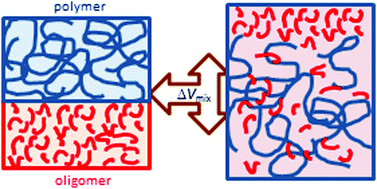Predicting oligomer/polymer compatibility and the impact on nanoscale segregation in thin films†
Abstract
Compatibility between oligomers and polymers was systematically assessed using differential scanning calorimetry (DSC) and was correlated with similarity in saturation and solubility parameter. These measurements enabled validation of detailed volume of mixing calculations using Statistical Association Fluid Theory (SAFT-γ Mie) and molecular dynamics (MD) simulations, which can be used to predict behaviour beyond the experimentally accessible conditions. These simulations confirmed that squalane is somewhat more compatible with poly(isoprene), “PI” than poly(butadiene), “PB”, and further enabled prediction of the temperature dependence of compatibility. Surface and interfacial segregation of a series of deuterated oligomers was quantified in rubbery polymer films: PI, PB and hydrogenated poly(isoprene) “hPI”. A striking correlation was established between surface wetting transition and mixtures of low compatibility, such as oligo-dIB in PB or PI. Segregation was quantified normal to the surface by ion beam analysis and neutron reflectometry and in some cases lateral segregation was observable by AFM. While surface segregation is driven by disparity in molecular weight in highly compatible systems this trend reverses as critical point is approached, and surface segregation increases with increasing oligomer molecular weight.



 Please wait while we load your content...
Please wait while we load your content...